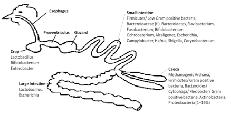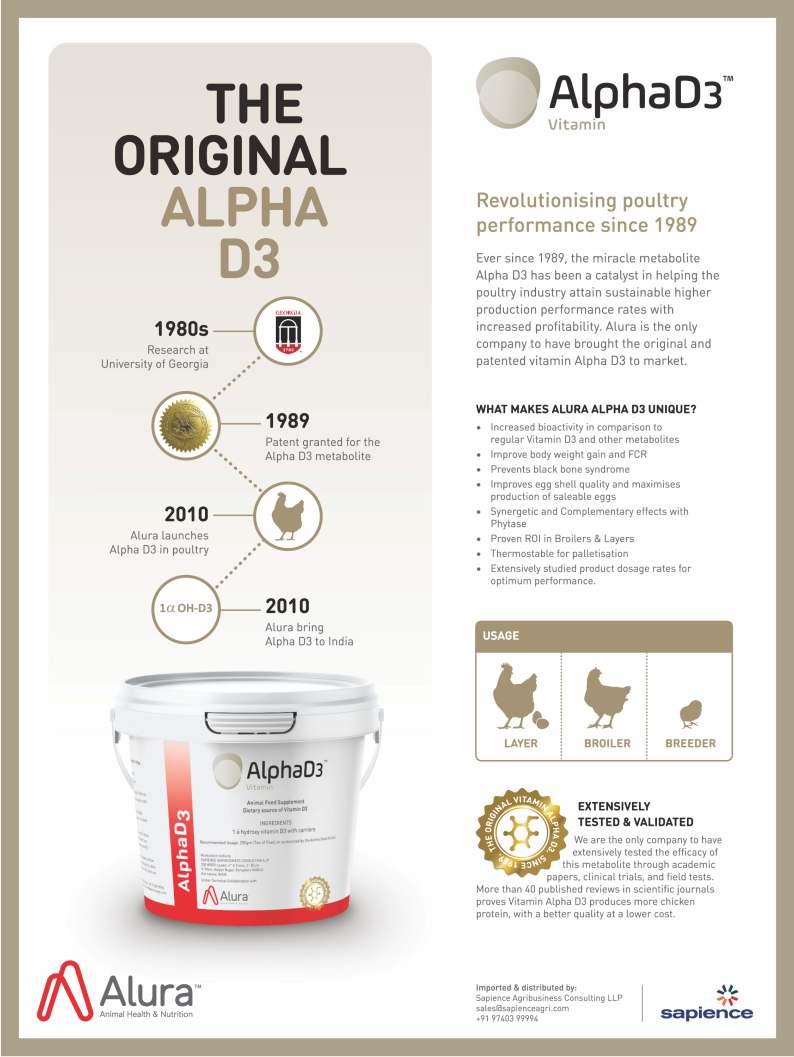
6 minute read
Dysbacteriosis – A Complex Problem in Poultry
1*Yallappa M. Somagond , Gaurav Kumar1 2 3, Pooja Devi and Mahesh Kajagar
1Research Scholar, Animal Physiology Division, ICAR-NDRI, Karnal-132001 2MVSc (Animal Nutrition), KVASU, Kerala 1*Corresponding author Email – somagondyallappa@gmail.com
Advertisement
Yallappa M. Somagond
Gut health is pivotal to the development, health and well being of production animals. Chicken's gastrointestinal tract plays an important role in the preservation of digestive function through its ability to modify host physiological processes required to maintain intestinal microbiota, primarily by eliminating harmful microorganisms and pathogens, preventing invasion, and hence preventing colony formation. The role of commensal microbiota and balance of intestinal microbiotaismoreimportantforguthealth andproductionperformanceofpoultry.An effective and sustainable GIT (Gastrointestinal tract) physiology requires balanced intestinal health. Enhanced gut health, which explains improved growth and FCR, contributes to better digestion and absorption of nutrients. Commensal microbiota helps in the production of intestinal mor-phological structures, modulates immune responses, provides defence against intestinal diseases and helps to enhance nutrient digestion and absorption. The GIT functions include digestive, absorbant, metabolism, immunology and endocrinology. Any disruption in GIT microbiota will affect one ormoreofthethesesystemicfunctions. The word dysbacteriasis was coined in the mid 1990s for the first time to describe a digestive imbalances in poultry which was known to be correlated with many changes in animal production and conditions. Dysbacteria or dysbiosis is character-ised as a disease-associated"imbalance"in the gut microbial population. The increase or loss of group members or changes in relative microbial abundance may be responsible for this imbalance. This imbalance is due to three fundamental reasons: (1) Commensal flora insufficiency (2) Diversity loss: a significant imbalance in the usual commensal flora (3) Infective flora interacting with the commensal microbiome. This disequibrilium is often marked by inflammation and shortening of the intestines, these effects production performance of birds.There fore by eliminating pathogenic bacteria and fostering beneficial bacteria, it is necessary to maintain a healthy intestinal microflora. Healthy poultry intestinal health is closely correlated with the typical gastrointestinal microflora's ecological balance and production performance.
Figure 1: Spatial distribution of most common and abundant bacterial taxa in GIT of chicken (Shang et al. 2018)
The most common and abundant
bacterial taxa spatially distributed in GIT of chicken In the Gastrointestinal system of the chicken, each bacterium is adapted to its own ecological niche and synergistic with other bacterial species in the same population. Depending on bird age, location and dietary components of the GI system, the composition and function of such groups have been found to vary.
Causes of dysbacteriosis or altered microbiota
In birds affected with dysbacteriosis or dysbiosis there is more involvement of bacteroidetes and clostridium species. Important changes have been identified in intestinal microbiota in relation tothe host genotype. Dietary effects have been identified for the bowel microbiota and an growing protein density contributing to an increase in microbiota members mainly bacteroidetes and clostridium family. Dysbiosis may be attributed to starvation cycles or intestinal injuries caused by anti-nutrition factors, mycotoxins, rancid and enteropathogens like coccidiosis. It is worth noting that dysfunctional micro-flora is often associated with intestinal problems and decreased growth or degradation in feed conversion.
Factors leading to dysbacteriosis or
dysbiosis: Main contributing factors are following:
1. Stress and immuno suppression:
Healthy gut environment is often influenced by many stress factors for birds, such as handling, transport, overcrowding, sudden environmental changes etc., Any stressful condition in poultry may predispose them to growth of pathogenic bacteria, as they may alter the intestinal environment to increase the risk of pathogens. 2. Dietary factors: Diet and feed management can greatly impact the
use and distribution of nutrients in the intestines. There are serious health concerns, especially in the early phases of chick development, due to improper nutrition and unhygienic climate in GIT. Nutritional defect due to ration composition imbalances, grain accumulation, microbial load on feed affect gut health. The diet's nature, such as non-starch polysaccharide (NSP), particularly soluble fractions of the diet, is a substrate for the production of unwanted bacteria and the accumulation of fermentation products which seriously affect the intestine. 3. Gut micro flora: In protecting intestinal integrity, the microbial equilibrium of the gut is extremely essential as it is having positive function in intestinal flora control and in stimulating intestinal wall growth. The change in the micro flora composition frequently leads to loss of production and productivity without any clinical signs. The diverse bacterial population of the gut micro-flora is essential for proper development of intestinal morphology, nutrition, immune responses and changes in resistance to colonisation. 4. Health status: Conditions such as coccidiosis and ovine plague have a significant effect on intestinal integrity. Infections, wounds and injuries also affect good health by preventing proper feed consumption
5. Intestinal protozoa and parasites:
immune suppressant disease; abrupt dietary changes; wheat, rye or fish meal containing diets; and natural intestinal micro-flora changes from antibiotic treatment or vaccination.
Signs of dysbacteriosis
Change in intestinal microflora, malabsorption of nutrients, undigested feed in faeces, decrease growth, ruffled feathers, wet litter and birds are offcolour or poor pigmentation and lack of uniformity in growth. Decreased FCR and production performance of broilers.In the gut, more mucosal and more goblet cells are formed in response to microbiota changes. This leads to slimmer and sometimes watery intestines. Histologically, tunica muscularis is decreased in thickness, the fusion of villus is increased and the length of the villi is shortened. The intestinal tone, the elasticity of the gut wall, thickness and overall strength of the intestinal wall are decreased during necropsy. It is flaccid when cutting the intestine in contrast with normal intestine shows immediate curl up after

cutting edges. Figure 2: Photograph of necropsy ndings in dysbacteriosischicken(Inammation of the gut and Undigested particles in the colon). When birds are suffering from dysbacteriosis, there is wet litter, which may cause two forms of contact dermatitis arising from prolonged contact with the decaying litter, which may lead to pododermatitis and hockburn. These illnesses will put the birds to unnecessary stress and ultimately result in reduced growth rates.
Strategies to dysbacteriosis treat and prevent
Ÿ Proper management practises will prevent occurrence of bacterial infections in poultry i.e., by providing a safe, healthy environ-ment, by good manage mental practises in poultry farms, practise of standard procedures for bio-security between flocks and personnel working in farms. Follow up of routine practises like vaccination, parasite control, identifying and treating sick birds
Ÿ Microflora maintenance by use of feed enzymes such as OptiPhos Plus and Hostazym X are able to reduce the impact of anti nutritional factors and products like Albac G granulate, Flavomycin micro Granulate, B-Act premix micro Granulate and B-Act Soluble are able to minimise growth of potentially pathogenic bacteria in the gut
Ÿ In certain cases, acidification of feed can be useful. i.e., done by dietary modifications, use of feed enzymes and organic acids in feed to protect from microbial and fungal infections.
Ÿ Antimicrobial therapy medication or sub
Ÿ Controlofcoccidiosisandmycotoxins
Ÿ Weekly dysbacteriosis scoring should be done in the entire flock to support management decisions to boost bowel health
Ÿ
Use of probiotics, prebiotics application to promote gastrointestinal and microbiota production
Conclusion
Dysbacteriosis will negatively affect the gut health status and production performance of birds. Birds have a strong influence over the production for the reason that, intestinal epithelium and gut health are very important in modulating physiological functions like immunity, nutrient digestion, intestinal barrier integrity, growth and development. So it is important to maintain gut microbita of bird throughout the growth cycle. “Healthy ” intestinal microbiota point toward the energy saving for the host that increases the birds' productivity. Because of conditions like dysbacteriosis, poor health cost significantly to poultry farmers, when compared to labour costs, litter and ventilation. It is therefore essential that intestinal health is maintained by basic management practises which play an important role in preventing this complex problem. r









